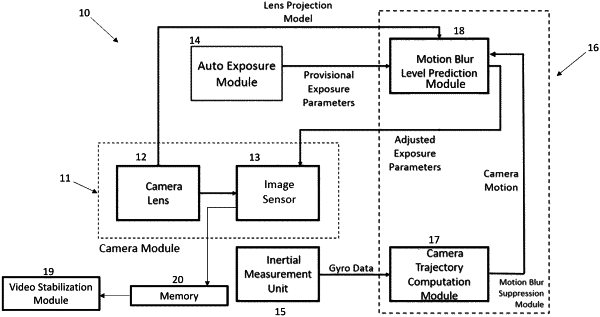| CPC H04N 23/6845 (2023.01) [H04N 23/683 (2023.01); H04N 23/6811 (2023.01); H04N 23/6812 (2023.01)] | 15 Claims |

|
1. A method at an image acquisition system for reducing camera motion blur, wherein the image acquisition system comprises a camera module including an image sensor and a lens, the lens being associated with a lens projection model, the method comprising:
determining, by one or more processors, a set of provisional exposure parameters to acquire each of successive image frames for a video stream, the provisional exposure parameters including a provisional exposure time in combination with a provisional gain;
before acquiring an image frame for a video stream, measuring, by the one or more processors, data related to a camera module motion during a time window;
determining, by the one or more processors, the camera module motion based on measured measurement data related to a camera module motion and predicting a camera motion blur during acquisition of the image frame based at least on the camera module motion and the lens projection model;
determining, by the one or more processors, whether the predicted camera motion blur exceeds a threshold;
in response to determining that the predicted camera motion blur exceeds the threshold, determining, by the one or more processors, a reduction of the provisional exposure time determined to acquire the image frame so that the predicted camera motion blur reaches the threshold, and determining whether a corresponding increase in the provisional gain determined to acquire the image frame is below a maximum gain value,
in response to determining that said corresponding increase in the provisional gain is below the maximum gain value, adjusting, by the one or more processors, the provisional exposure time and gain by applying said reduction and corresponding increase; and
acquiring the image frame using the adjusted provisional exposure time and gain.
|